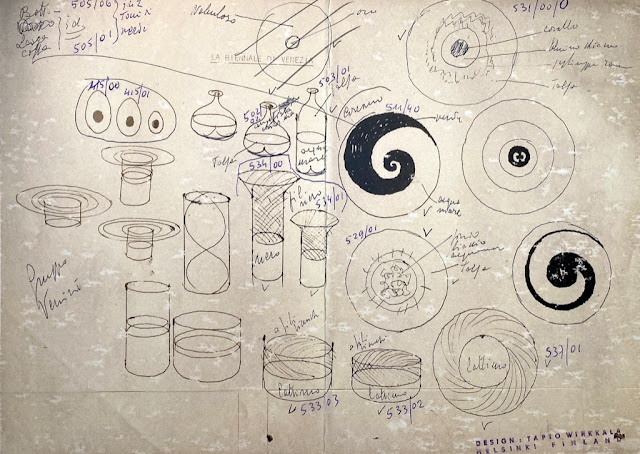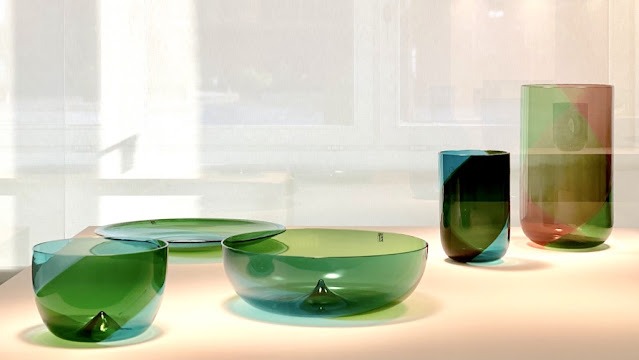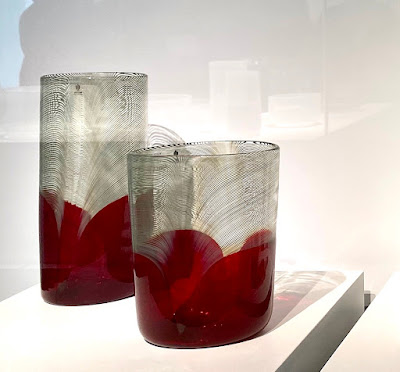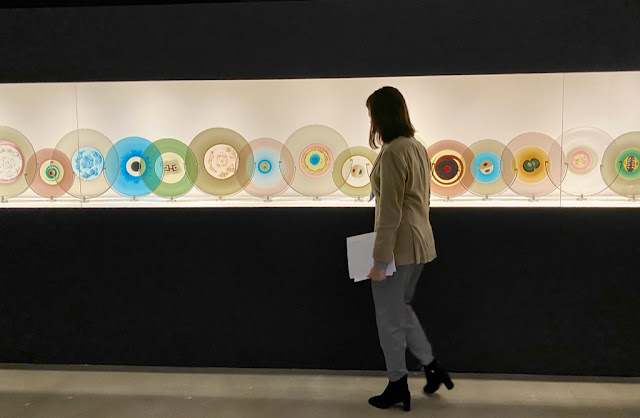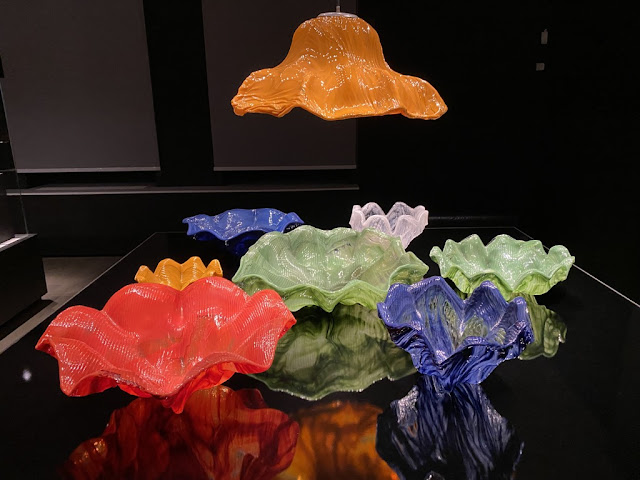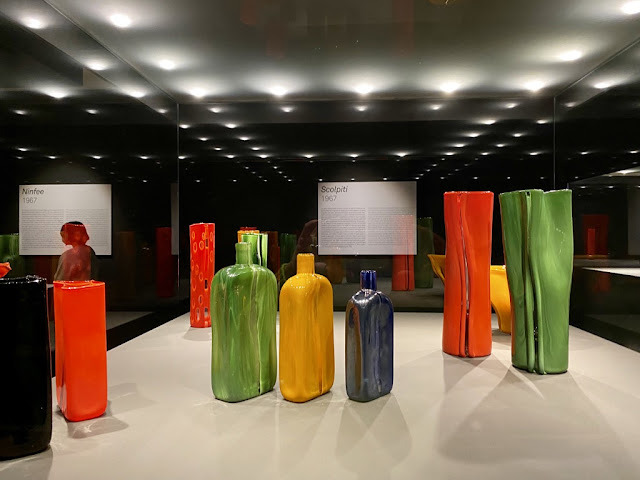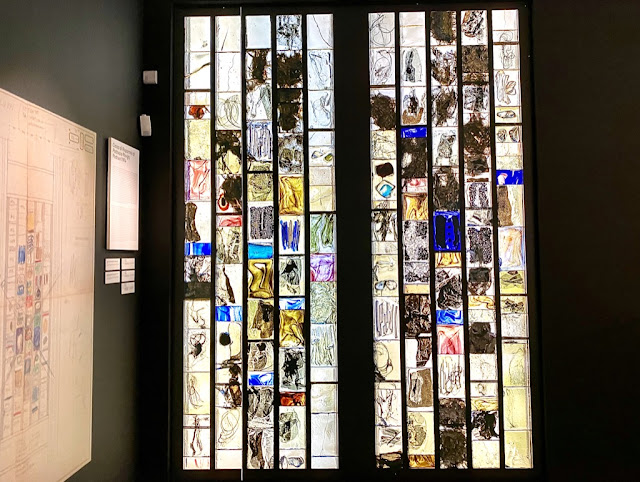
Le Stanze Del Vetro
Tapio Wirkkala at Venini - Toni Zuccheri at Venini
Twin Exhibitions
Tapio Wirkkala at Venini and Toni Zuccheri at Venini are two side-by-side exhibitions at Le Stanze del Vetro - until March 13 - curated by Marino Barovier and dedicated to two artists and designers who were active at the furnace mainly in the second half of the 1960s. They both contributed, with their strong personalities, to the character of the production of the glassworks. In those transformational years, Venini was able on the one hand to present new models without giving up the use of colour, and on the other to respond to the new minimalist requirements in the world of design. The first aspect was developed in particular by Toni Zuccheri, to whom we owe the extraordinary series of fowl and farmyard animals, which were soon joined by vases in bright colours with organic lines, inspired by the plant kingdom. From 1966 the furnace also entered in a collaboration with Finnish designer Tapio Wirkkala, who brought his experience with glass at the Iittala glassworks to Venice by combining Nordic culture with Murano craft, achieving remarkable results.
Tapio Wirkkala
Lapponi - 1966
Lapponi - 1966
A distinctive feature of the
design of these objects is the wide flared rim, the upper section of which brings to
mind a stylised headdress. From the available graphic evidence, it can be argued that
the series was created initially for the Venice Biennale of 1966.
"I have the feeling that Tapio's happiest moments were anchored in Venice and Lapland. In the South and the North. They share a reflection of water, the limpid air, the movement of a long dark boat".
Maaria Wirkkala
from the catalogue Tapio Wirkkala at Venini
Maaria Wirkkala
from the catalogue Tapio Wirkkala at Venini
Tapio Wirkkala
Medusa - 1966
Exhibited at the 33rd Biennale of Venice in 1966, the Meduse series is an attempt by
Wirkkala to combine Nordic design with the traditional Murano techniques, such as
filigrana.
Tapio Wirkkala alla Venini - installation view - photo - Enrico Fiorese - copyright -Tapio Wirkkala - SIAE - 2021
courtesy - Le Stanze del vetro
Tapio Wirkkala
Ai Lieti Calici - 1966
Ai Lieti Calici - 1966
"When my parents visited Venice for the first time, Paolo Venini sent his private gondola to pick them up from their hotel."
Maaria Wirkkala
from the catalogue Tapio Wirkkala at Venini
from the catalogue Tapio Wirkkala at Venini
Tapio Wirkkala
Gondolieri - 1966
This series has the characteristic contours of
the gondolier’s hat.The vases, with a cylindrical
body and wide rim, are made of transparent glass with several colours joined by the incalmo technique.
Tapio Wirkkala
Bolle - 1966-1967
The most famous Bolle series designed by Tapio Wirkkala, have enjoyed considerable success over the years. The series includes vases with evocative shapes,
with a flattened globular body. These objects are made of thin, transparent glass in
two colours joined by the incalmo technique.
Tapio Wirkkala
Silma - 1966-1967
The Silma series is made of monochrome glass with the inclusion of
two large polychrome murrine, each with a circular core, indicated in the catalogue as
‘eyes’ from which the term Silma comes, which in Finnish means ‘eye’.
Coreani - 1966-1967
Coreani is one of the best known series designed by Tapio Wirkkala, recognisable by its distinctive
two-colour technique with large twisted bands generally in verde mela and acquamare
transparent glass, but also, to a lesser extent, in green and purple. The basic idea is
that of a spiral, a recurring theme in Wirkkala’s work. In this case the two colours spiral
around each other to form the walls of the piece. The working process provides initially
for the production of a pea (small hollow glass ball) of cristallo on which two bands
of colour are applied under heat, obtaining a two-colour ball.
Coppe - 1970-1981
Tapio Wirkkala
Filigrane di Tapio - 1970
Indicative of Wirkkala’s production for Venini in the 1970s, the Filigrane di Tapio include a
series of vases and bowls in white - lattimo - and black filigrana joined
by the incalmo technique. These are artefacts in which the essentiality of the design
is accompanied by a play of opaque and semitransparent effects, which seems aimed
at marrying design and tradition.
Pavoni - 1981c.
For the Pavoni, Wirkkala used the filigrana technique and that of fenicio glass to create artefacts with
a characteristic structure where the continuity of the filigrane is interrupted by a kind
of vertical groove which changes the pattern.
Piatti di Tapio - 1967-1981
In his approach to Murano glass Tapio Wirkkala also dealt with murrina, which he interpreted in his own way. He created some unusual large polychrome murrine with
geometric motifs or abstract designs. Some of these murrine were used in the production of a series of transparent plates with two or three colours joined by the incalmo
technique. In the Venini Glassware Catalogue, 1967 the series was referred to
as Piatti di Tapio, eleven coloured variants were proposed, each marked by a letter of
the alphabet. Some examples were exhibited in 1968 at the 34th Venice Biennale and
in Turin, at the second edition of Eurodomus.
Marino Barovier
Curator - 10 exhibitions
Stanze del Vetro
Experimentation with the material of glass and the processes for shaping it are the
distinctive marks of Toni Zuccheri who, while still a student of architecture, was invited
to the Venini glassworks with the task of designing a bestiary in glass, which was displayed at the Venice Biennale in 1964. In this way he began an association which, albeit intermittently, continued for a good part of his life. He also worked as an architect and later became interested in communications.
Tronchi - 1967
Toni Zuccheri
Ninfee - 1967
The Ninfee series, most of which are large in size are intended as plant holders, receptacles for bunches of flowers or table centrepieces of a remarkable figurative impact. They are distinguished by their original
shape with strong ribbing and waving rims, associated with a glass pattern of thin
ribbing and with evocative chromatic effects.
Scolpiti - 1967
The Scolpiti series includes vases of great sculptural and figurative significance
made of opaque glass and cristallo glass they have in common the presence of two vertical contraposed ‘fissures’ in cristallo glass interrupting the continuity of the coloured
surface. Some pieces of this series were exhibited in Venice at the ‘contested’ Biennale of
1968.
Toni Zuccheri
Crepuscoli - 1964
The Crepuscoli series of coloured transparent glass vases, of which the distinctive
mark is the presence of a convexity and/or concavity visible in transparency is mostly made in a different colour from the walls of the piece. In some of these
models the personal reflection of Zuccheri on the works of Thomas Stearns of 1961–62
is evident. Examples of Crepuscoli
were exhibited in 1964 at the 32nd Venice Biennale and in New York, at the exhibition
Glass: Czechoslovakia and Italy held at the Museum of Contemporary Crafts.
Grovigli - 1964
The series represents, together with Giade, an experiment on the use of metal filaments to obtain new glass patterns by applying or incorporating them in vitreous substance. The theme, already tackled by Ercole Barovier with the technique of colorazione a caldo senza fusione, in particular in the series Crepuscolo - 1930s - is developed here in a completely personal way with unprecedented results precisely due to the formal value Zuccheri assigns to the groviglio - tangle - of threads in their solidity and their bundling in suspension in the vitreous mass.
Toni Zuccheri
Giade - 1964
The series stems from Zuccheri's experiments with vitreous materials in the early years of his collaboration with Venini. Bottles and vases made with an unusual opaque glass enhanced by filaments of copper or brass applied under heat and embedded in the wall of the piece. Their presence creates a mottled surface evoking that of the semi-precious stone from which these glass pieces take their name. Nine pieces were exhibited at the 1964 Venice Biennale.
"And here a Venetian, Toni Zuccheri ... an artist of good taste
who “discovered” for me and implemented, at Murano, at the school
of Ca’ Venini, that knowledgeable and ingenious school, “discovered”, I repeat, all or
nearly all that can be done and has not yet been done with thick glass or inside thick
glass with the colours of the glass pieces that make it up and with their different textures, with the insertions of murrine, of canes, of threads and delicate nets of metal or
of filigrana. A new world.’
Gio Ponti
Domus - March - 1966
Gio Ponti / Toni Zuccheri
Vetrate Grosse
Cassa di Risparmio di Padova e Rovigo
Padova - 1964
Toni Zuccheri
Bestiario
Bestiario
At the end of 1961, while still a university student, Toni Zuccheri was introduced to the
Venini glassworks, with the objective of creating a bestiario - bestiary - in glass. The project came to fruition at the 32nd Venice Biennale in 1964, where two guinea fowls and
a turkey in murrine glass were exhibited, together with three ducks in polychrome
glass.
Toni Zuccheri
Tacchino 1963-1964
Gabbiano - 1980 - Gabbiano - 1980 - Gallo - 1979
Toni Zuccheri
Toni Zuccheri
Fenice - 1986-1987 Having re-established his association with the firm now under new ownership, Zuccheri continued his
ceaseless research which would lead to new challenges, consisting in part in the development of subjects already dealt with in the preceding years in other contexts. This
was the case with the Fenice - Phoenix - a subject he had tackled on a smaller scale
in the study and realisation of the Fenice d’Oro prize for the best actor/actress at the
Venice Film Festival in 1981. Between 1986 and 1987, with the cooperation of the
Brustolin art foundry of Verona with which Zuccheri usually worked, the project took
the shape of a large-scale fenice in lost wax bronze with elements of mostly opaque
polychrome glass.
Toni Zuccheri
Gio Caroli - 1979 - Canne Sovrapposte - 1982
At the end of the 1970s we find a small series of glass pieces made by Venini and designed by Toni Zuccheri for the Valenza goldsmith company Gio Caroli. These were I Falconi, a series of containers with the
characteristic lid in black glass bearing the stylised head of a falcon, shaped by grinding. Following this experiment Zuccheri studied two bottles
and two vases in glass with thin superimposed polychrome canes worked at the wheel
which were included in the Venini catalogue. The model of the bottle is surmounted by a
stylised bird’s head in verde antico opaque glass or in avorio glass worked at the wheel.
Toni Zuccheri
Membrane - 1972
The Membrane series is an attempt by Zuccheri to combine an essential design, like that of the
1970s, with new research on colour and new production techniques. The result is a
series of artefacts, almost all spherical or cylindrical in shape, in cristallo glass with
an internal diaphragm - a membrane. In 1972, in the last Biennale devoted to the decorative arts,
a series of vases called Membrane ondate bicolori was exhibited, where the internal
diaphragm was enhanced by striations of irregular or coiled colours.
documentary film maker
Toni Zuccheri - Pezzi Sparsi







